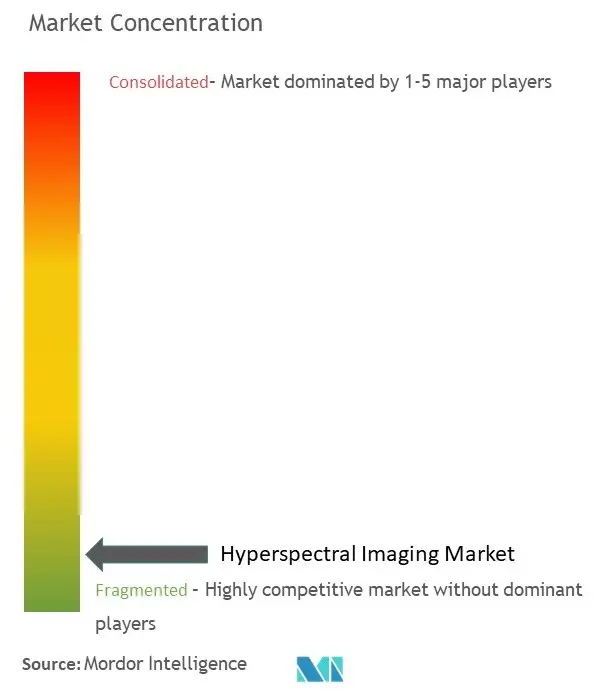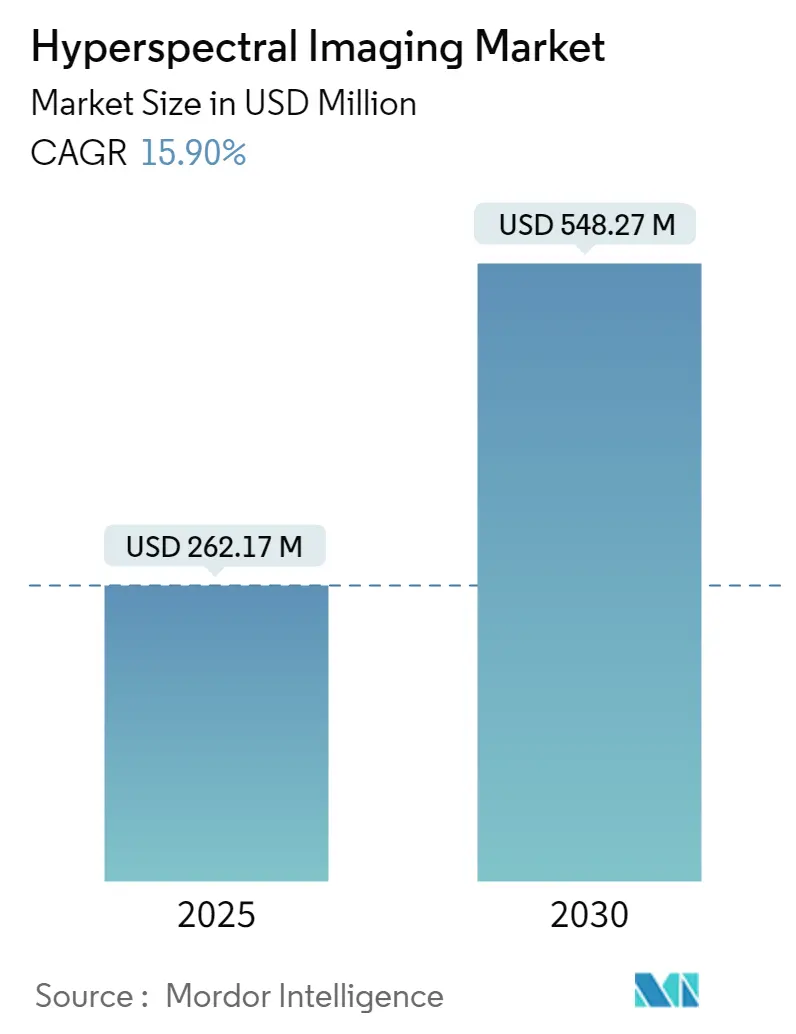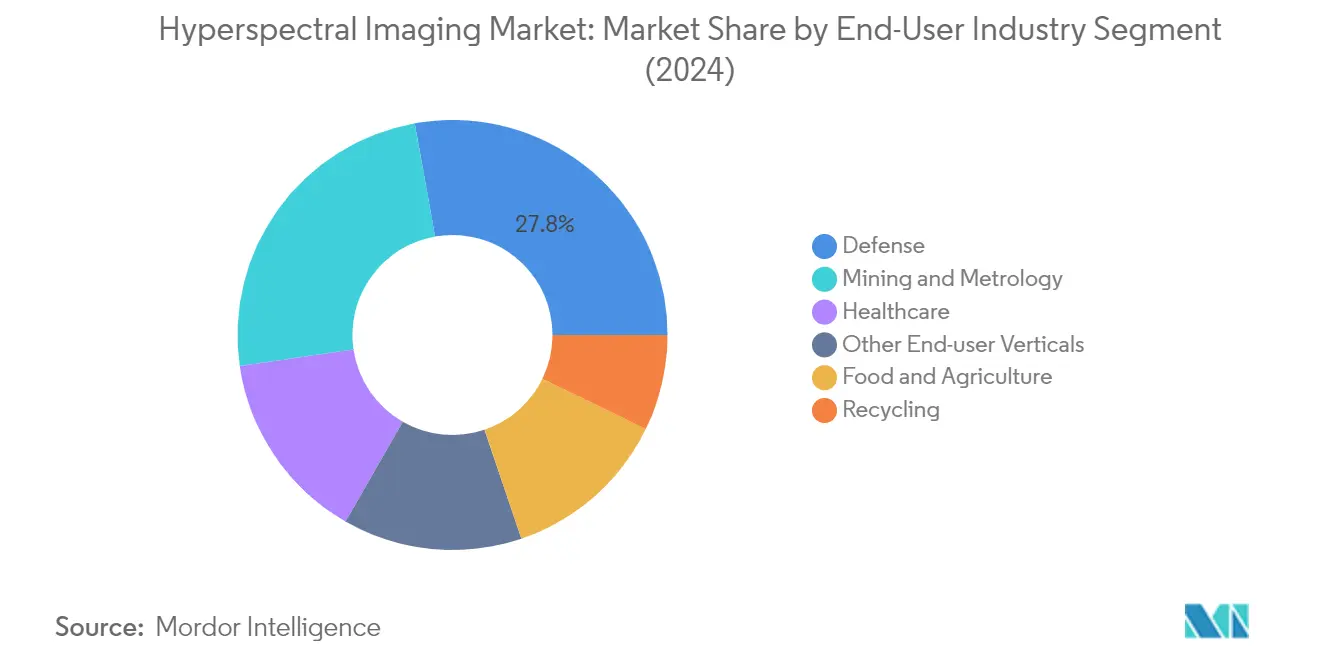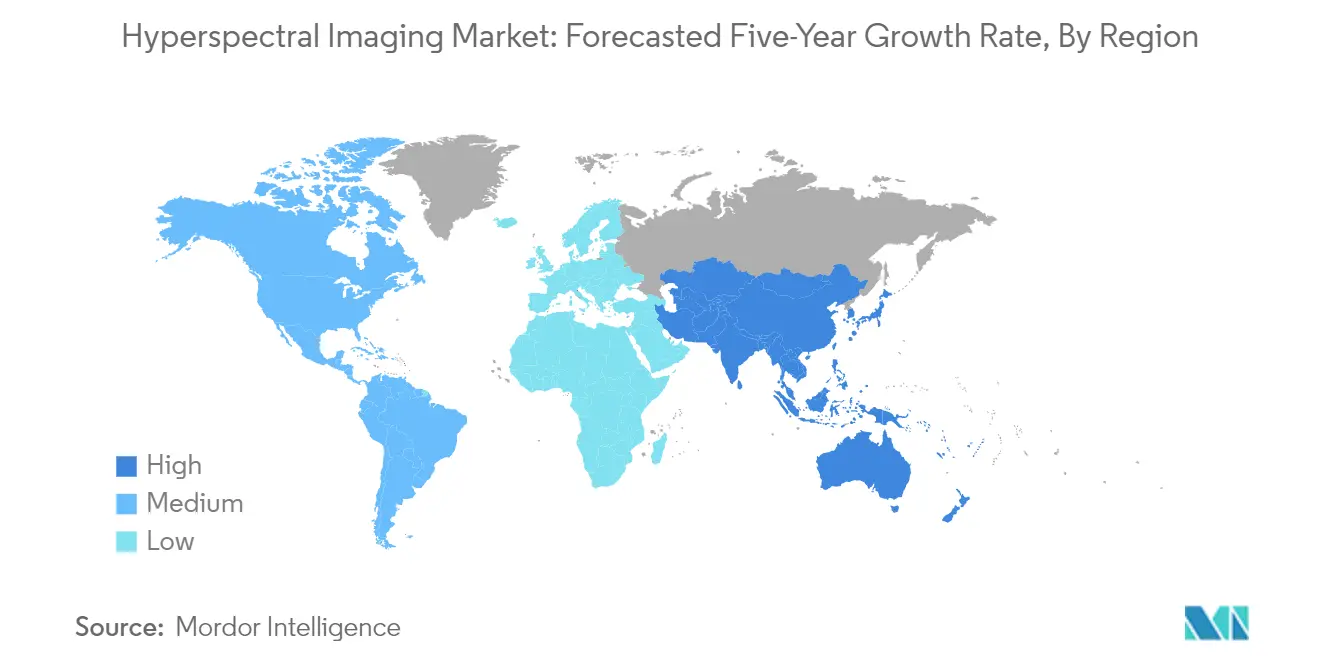Hyperspectral Imaging Market Analysis
The Hyperspectral Imaging Market size is estimated at USD 262.17 million in 2025, and is expected to reach USD 548.27 million by 2030, at a CAGR of 15.9% during the forecast period (2025-2030).
The hyperspectral imaging industry is experiencing significant transformation driven by escalating global security concerns and defense modernization initiatives. Global military spending reached a record high of USD 2.44 trillion in 2023, with the United States leading at USD 916 billion, reflecting the growing emphasis on advanced surveillance and reconnaissance capabilities. This surge in defense spending has catalyzed innovations in defense imaging technologies, particularly in airborne and satellite-based applications. The integration of hyperspectral imaging in military and defense applications has become increasingly crucial for enhanced target detection, camouflage identification, and battlefield surveillance.
The industry is witnessing substantial technological evolution through strategic investments and product innovations. In November 2023, Kuva Space secured EUR 16.6 million in Series A funding to expand its hyperspectral imaging capabilities and AI analytics platform. This was followed by SPECIM's launch of an upgraded FX50 middle wave infrared hyperspectral camera in December 2023, featuring enhanced spectral range and resolution capabilities. The continuous advancement in product capabilities and the emergence of new market players are reshaping the competitive landscape and driving innovation across various application sectors.
Environmental monitoring and waste management applications are gaining prominence in the hyperspectral imaging market. With global municipal solid waste projected to reach 3.4 billion metric tons by 2050, there is an increasing focus on utilizing hyperspectral imaging for efficient waste sorting and recycling operations. The technology's ability to identify and differentiate materials based on their unique spectral signatures has made it invaluable for environmental monitoring, including the detection of harmful algal blooms, assessment of vegetation health, and monitoring of greenhouse gas emissions.
The healthcare sector represents a significant growth avenue for hyperspectral imaging applications, particularly in medical diagnostics and surgical procedures. In China alone, over 345,800 new cases of breast cancer were recorded in 2023, highlighting the critical need for advanced imaging technologies in disease detection and treatment. Recent developments include the integration of medical hyperspectral imaging in surgical microscopes for real-time tissue analysis and the development of non-invasive diagnostic tools. The technology's ability to provide detailed tissue characterization and blood flow analysis has made it increasingly valuable in medical applications, from early disease detection to image-guided surgery.
Hyperspectral Imaging Market Trends
Technological Advancements
The hyperspectral imaging industry has witnessed significant technological evolution, particularly in the miniaturization and enhancement of imaging systems. In January 2023, Panasonic Holdings Corporation announced the development of the world's highest sensitivity hyperspectral camera technology by applying compressed sensing technology, making it possible to identify slight color differences that are hard to discern with the naked eye while maintaining the usability of a conventional color camera. The advancement in micro-hyperspectral technology has addressed the need for small, lightweight, and efficient hyperspectral imaging instruments capable of being deployed in harsh environments. Companies like Specim have introduced next-generation products, such as the Specim GX17 launched in May 2023, featuring a maximum frame rate of 800 Hz with 480 spatial pixels, providing 50% more capability than conventional QVGA sensor-based hyperspectral cameras.
The integration of hyperspectral imaging with unmanned aerial vehicles (UAVs) and artificial intelligence has opened new possibilities across various applications. In June 2023, Hinalea Imaging introduced the Model 4455, an Extended SWIR camera covering the 1200-2100 nm spectral range, designed to detect and classify chemicals and materials invisible to near-infrared or typical shortwave-infrared systems. The technology sector has also witnessed significant developments in ultraviolet hyperspectral imaging, with companies like Resonon releasing the Pika NUV2, the only ultraviolet plus visible hyperspectral camera currently available commercially, featuring 255 adjacent spectral channels at each pixel with a spectral resolution of 3.2 nm. These technological improvements have made the systems more user-friendly and accessible while maintaining high performance standards.
Increasing Demand for Data Accuracy and Consistency
The growing need for precise and reliable data across various industries has become a significant driver for hyperspectral imaging adoption. In the defense sector, hyperspectral imaging provides crucial capabilities for identifying ground disturbances, detecting camouflaged objects, and identifying chemical and biological hazards with unprecedented accuracy. The technology's ability to detect objects at a resolution of just 20% of a pixel has made it invaluable for military surveillance and security applications. Furthermore, in the healthcare sector, hyperspectral imaging has demonstrated superior accuracy in cancer detection and diagnosis, with the World Health Organization estimating that early detection through advanced imaging technologies could significantly impact the management of over 422 million adults with diabetes and various forms of cancer.
The technology's application in food quality inspection and mineral identification has showcased its superior accuracy compared to traditional imaging methods. Hyperspectral imaging systems can acquire images in over a hundred contiguous spectral bands, allowing for precise characterization and identification of materials. For instance, in the mining sector, the technology can effectively differentiate between approximately 4,000 natural minerals on Earth, each with unique spectral characteristics. The integration of hyperspectral data with other technologies, such as LiDAR, has further enhanced data accuracy, particularly in environmental studies and geological surveys. This combination provides significant potential for various applications, with the cross-calibration approach enabling rigorous illumination correction and compensation for drawbacks of passive HSI systems, such as illumination changes over time and cloud shadowing effects.
Segment Analysis: By End-User Industry
Defense Segment in Hyperspectral Imaging Market
The defense segment dominates the global hyperspectral imaging market, commanding approximately 28% market share in 2024. This significant market position is driven by the extensive application of spectral imaging in military surveillance, reconnaissance, and security operations. The technology's ability to detect camouflaged objects, identify chemical mapping hazards, and assess initial indications of corrosion and metal fatigue on aircraft and naval vessels makes it invaluable for defense applications. The integration of hyperspectral imaging with unmanned aerial vehicles (UAVs) has further enhanced its utility in aerial and ground reconnaissance activities. Defense organizations worldwide are increasingly adopting this technology for improved target detection, identification of disturbed surfaces, and enhanced situational awareness capabilities.
Recycling Segment in Hyperspectral Imaging Market
The recycling segment is emerging as the fastest-growing sector in the hyperspectral imaging market, projected to grow at approximately 17% CAGR from 2024 to 2029. This remarkable growth is driven by the increasing adoption of hyperspectral cameras in automated sorting processes, particularly in plastic recycling facilities. The technology's ability to detect minimal differences in similarly colored materials and distinguish between various polymer types such as PE, PP, PS, PET, and PVC has made it invaluable in recycling operations. The integration of hyperspectral imaging with artificial intelligence and machine learning algorithms is revolutionizing waste management systems, enabling more efficient and accurate material sorting. This technology is particularly crucial in achieving near-perfect purity in recycling centers, addressing the growing global concern over plastic waste management and supporting sustainable practices.
Remaining Segments in Hyperspectral Imaging Market
The hyperspectral imaging market encompasses several other significant segments including mining and metrology, healthcare, food and agriculture, and other end-user verticals. The mining and metrology segment leverages the technology for mineral mapping and precise measurement applications. The healthcare sector utilizes medical hyperspectral imaging for medical diagnostics, surgical procedures, and wound assessment. In the food and agriculture segment, the technology plays a crucial role in agricultural imaging for crop monitoring, quality control, and contamination detection. These segments collectively contribute to the market's diverse application landscape, each bringing unique requirements and driving innovation in hyperspectral imaging technology development.
Hyperspectral Imaging Market Geography Segment Analysis
Hyperspectral Imaging Market in North America
North America has established itself as the dominant force in the global hyperspectral imaging market, commanding approximately 36% of the market share in 2024. The region's leadership position is primarily driven by substantial investments in the defense and aerospace sectors, particularly in the United States. The presence of major market players, advanced technological infrastructure, and robust research and development activities have contributed significantly to market growth. The region's focus on healthcare applications, particularly in cancer detection and surgical procedures, has further accelerated market expansion. Additionally, the increasing adoption of hyperspectral imaging in food quality assessment, precision agriculture, and environmental monitoring has created diverse growth opportunities. The strong regulatory framework, coupled with favorable government initiatives supporting technological innovation, has created an environment conducive to market development. The region's emphasis on surveillance and security applications, particularly in military and law enforcement, continues to drive demand for hyperspectral imaging solutions.
Hyperspectral Imaging Market in Europe
Europe has demonstrated remarkable progress in the hyperspectral imaging market, with an impressive growth rate of approximately 15% from 2019 to 2024. The region's market development has been significantly influenced by its strong aerospace industry and the European Space Agency's initiatives in Earth observation programs. The market has benefited from extensive research collaborations between academic institutions and industry players, particularly in countries like Germany, France, and the United Kingdom. The region's focus on environmental monitoring and agricultural applications has created substantial opportunities for market expansion. European companies have been at the forefront of developing innovative hyperspectral imaging solutions, particularly in industrial automation and quality control applications. The strong emphasis on waste management and recycling applications has further diversified the market opportunities. The region's robust healthcare infrastructure and increasing adoption of advanced medical imaging technologies have also contributed to market growth.
Hyperspectral Imaging Market in Asia-Pacific
The Asia-Pacific region represents the most dynamic market for hyperspectral imaging, projected to grow at a remarkable rate of approximately 17% from 2024 to 2029. The region's market is characterized by rapid technological adoption and increasing investments in defense and surveillance applications. Countries like China, Japan, and India are leading the charge in implementing hyperspectral imaging technology across various sectors. The region's massive agricultural sector has emerged as a key application area, with growing adoption in precision farming and crop monitoring. The expanding industrial sector, particularly in quality control and automated inspection systems, has created substantial market opportunities. The increasing focus on environmental monitoring and disaster management has further driven the adoption of hyperspectral imaging solutions. The region's growing healthcare infrastructure and increasing investments in advanced medical imaging technologies have also contributed to market expansion. The hyperspectral imaging market size in Asia-Pacific is expected to witness significant growth due to these factors.
Hyperspectral Imaging Market in Rest of the World
The Rest of the World region, encompassing Latin America, the Middle East, and Africa, presents emerging opportunities in the hyperspectral imaging market. The market growth in these regions is primarily driven by increasing investments in defense modernization, particularly in Middle Eastern countries. The agricultural sector in Latin America has shown growing interest in adopting hyperspectral imaging for precision farming and crop monitoring applications. The region's focus on environmental monitoring and resource exploration, particularly in the mining sector, has created new opportunities for market expansion. Healthcare modernization initiatives in several countries have led to increased adoption of advanced imaging technologies. The growing awareness about food quality and safety has stimulated interest in hyperspectral imaging applications in the food processing industry. The region's developing industrial sector and increasing focus on quality control have also contributed to market growth. Additionally, the remote sensing market and spectroscopy market are closely tied to advancements in hyperspectral imaging, further enhancing the region's growth prospects.
Hyperspectral Imaging Industry Overview
Top Companies in Hyperspectral Imaging Market
The hyperspectral imaging market is characterized by continuous product innovation, with hyperspectral imaging companies focusing on developing smaller, more affordable, and user-friendly imaging systems. Major players are investing heavily in research and development to enhance spectral and spatial resolution capabilities while integrating advanced technologies like artificial intelligence and machine learning for data processing. Companies are strategically expanding their geographical presence through distribution networks and partnerships, particularly in emerging markets. Operational agility is demonstrated through vertical integration strategies, with several companies manufacturing critical components in-house to maintain quality control and cost-effectiveness. The industry has witnessed strategic moves toward developing specialized solutions for specific applications, including precision agriculture, industrial inspection, and defense, while companies are increasingly offering end-to-end solutions combining hardware and software capabilities.
Market Dominated by Specialized Technology Leaders
The hyperspectral imaging market exhibits a moderate level of consolidation, with specialized technology companies holding significant market share alongside larger conglomerates with diverse product portfolios. Companies like Specim, Headwall Photonics, and BaySpec have established themselves as pure-play vendors with comprehensive product offerings, while larger corporations like Corning Incorporated leverage their broader technological expertise and resources to compete in this space. The market structure is characterized by a mix of established players with global reach and regional specialists focusing on specific applications or geographical markets.
The industry has witnessed strategic consolidation through mergers and acquisitions, particularly as companies seek to expand their technological capabilities and market reach. Recent M&A activities have focused on acquiring complementary technologies and expertise, especially in software and data analytics capabilities. Companies are also forming strategic partnerships with software providers and system integrators to enhance their solution offerings. The market remains dynamic with new entrants focusing on niche applications, particularly in emerging areas such as handheld devices and drone-based systems, while established players continue to strengthen their positions through portfolio expansion and technological advancement.
Innovation and Integration Drive Market Success
For incumbent players to maintain and increase their market share, a multi-faceted approach combining technological innovation, application-specific solutions, and strong customer relationships is essential. Success factors include continuous investment in research and development to improve imaging quality and processing capabilities, development of cost-effective solutions to expand market accessibility, and establishment of comprehensive service and support networks. Companies must also focus on vertical integration and strategic partnerships to control costs and enhance solution offerings, while maintaining flexibility to adapt to evolving customer requirements across different industries.
Market contenders can gain ground by focusing on specialized applications and underserved market segments, while developing innovative solutions that address specific customer pain points. The relatively low threat of substitution provides opportunities for new entrants, particularly those offering innovative approaches to specific industry challenges. However, companies must navigate complex regulatory requirements, particularly in sensitive applications such as healthcare and defense. End-user concentration varies by application segment, with some sectors dominated by large institutional buyers while others feature more fragmented customer bases, requiring adaptable go-to-market strategies. Success in this market increasingly depends on the ability to provide complete solutions that combine hardware, software, and analytics capabilities while maintaining competitive pricing and strong technical support. The spectroscopy industry and remote sensing industry are closely linked to these advancements, offering further growth opportunities.
Hyperspectral Imaging Market Leaders
-
Galileo Group, Inc.
-
BaySpec Inc.
-
Specim Spectral Imaging Ltd
-
Corning Incorporated
-
Surface Optics Corporation
- *Disclaimer: Major Players sorted in no particular order

Hyperspectral Imaging Market News
- March 2024 - Specim revealed its collaboration with ETT, the top Machine Vision solutions provider in Chile. Through the partnership of Specim and ETT, clients in Chile and Peru will benefit from advanced imaging technology, professional assistance, and creative solutions that will enhance their achievements.
- January 2024 - Living Optics Limited, a trailblazer in computational imaging, introduced its newest release, the Living Optics Camera. This innovative product is designed to combine spectral imaging functionalities with computer vision, enabling developers to delve into and utilize the benefits of Hyperspectral Imaging in their projects. The debut of Living Optics signifies the result of its wide-ranging partnerships across various sectors, including computer vision, agriculture, healthcare, and security. The objective of this launch is to broaden the reach of their state-of-the-art technology to a wider audience.
Hyperspectral ImagingMarket Report - Table of Contents
1. INTRODUCTION
- 1.1 Study Assumptions and Market Definition
- 1.2 Scope of the Study
2. RESEARCH METHODOLOGY
3. EXECUTIVE SUMMARY
4. MARKET INSIGHTS
- 4.1 Market Overview
- 4.2 Industry Value Chain Analysis
-
4.3 Industry Attractiveness - Porter's Five Forces Analysis
- 4.3.1 Bargaining Power of Suppliers
- 4.3.2 Bargaining Power of Buyers
- 4.3.3 Threat of New Entrants
- 4.3.4 Threat of Substitute Products
- 4.3.5 Degree of Competition
- 4.4 Impact of COVID-19 Aftereffects and Other Macroeconomic Factors on the Market
5. MARKET DYNAMICS
-
5.1 Market Drivers
- 5.1.1 Technological Advancements
- 5.1.2 Increasing Demand for Data Accuracy and Consistency
-
5.2 Market Restraints
- 5.2.1 High Costs Associated with the Use of Hyperspectral Imaging
- 5.3 Patent Analysis
6. TECHNOLOGY SNAPSHOT - APPLICATIONS
- 6.1 Surveillance
- 6.2 Remote Sensing
- 6.3 Machine Vision/Optical
- 6.4 Medical Diagnostics/Research
7. MARKET SEGMENTATION
-
7.1 By End-user Industry
- 7.1.1 Food and Agriculture
- 7.1.2 Healthcare
- 7.1.3 Defense
- 7.1.4 Mining and Metrology
- 7.1.5 Recycling
- 7.1.6 Other End-user Verticals
-
7.2 By Geography***
- 7.2.1 North America
- 7.2.2 Europe
- 7.2.3 Asia
- 7.2.4 Australia and New Zealand
- 7.2.5 Latin America
- 7.2.6 Middle East and Africa
8. COMPETITIVE LANDSCAPE
-
8.1 Company Profiles*
- 8.1.1 Galileo Group, Inc.
- 8.1.2 BaySpec Inc.
- 8.1.3 Specim Spectral Imaging Ltd
- 8.1.4 Corning Incorporated
- 8.1.5 Surface Optics Corporation
- 8.1.6 Headwall Photonics Inc.
- 8.1.7 Resonon Inc.
- 8.1.8 HyperMed Imaging Inc.
- 8.1.9 Norsk Elektro Optikk AS
- 8.1.10 Cubert GmbH
- 8.1.11 XIMEA GmbH
- 8.1.12 HinaLea Imaging (TruTag Technologies Inc.)
- 8.1.13 ITRES Research Limited
- 8.1.14 Telops Inc.
- 8.1.15 Brimrose Corporation of America
9. VENDOR POSITIONING ANALYSIS - HYPERSPECTRAL IMAGING
10. INVESTMENT ANALYSIS
11. MARKET OPPORTUNITIES AND FUTURE GROWTH
Hyperspectral Imaging Industry Segmentation
The scope of the study primarily includes different types of cameras/imagers that are used for hyperspectral imaging applications, and the market is defined by the revenues accrued from the sale of these cameras across end-user industries, including food and agriculture, healthcare, defense, mining and metrology, recycling, among others.
The hyperspectral imaging market is segmented by end-user industry (food and agriculture, healthcare, defense, mining and metrology, recycling, and other end-user verticals) and by geography (North America, Europe, Asia Pacific, and Rest of the World). The market sizes and forecasts are provided in terms of value USD for all the above segments.
| By End-user Industry | Food and Agriculture |
| Healthcare | |
| Defense | |
| Mining and Metrology | |
| Recycling | |
| Other End-user Verticals | |
| By Geography*** | North America |
| Europe | |
| Asia | |
| Australia and New Zealand | |
| Latin America | |
| Middle East and Africa |
Hyperspectral ImagingMarket Research FAQs
How big is the Hyperspectral Imaging Market?
The Hyperspectral Imaging Market size is expected to reach USD 262.17 million in 2025 and grow at a CAGR of 15.90% to reach USD 548.27 million by 2030.
What is the current Hyperspectral Imaging Market size?
In 2025, the Hyperspectral Imaging Market size is expected to reach USD 262.17 million.
Who are the key players in Hyperspectral Imaging Market?
Galileo Group, Inc., BaySpec Inc., Specim Spectral Imaging Ltd, Corning Incorporated and Surface Optics Corporation are the major companies operating in the Hyperspectral Imaging Market.
Which is the fastest growing region in Hyperspectral Imaging Market?
Asia Pacific is estimated to grow at the highest CAGR over the forecast period (2025-2030).
Which region has the biggest share in Hyperspectral Imaging Market?
In 2025, the North America accounts for the largest market share in Hyperspectral Imaging Market.
What years does this Hyperspectral Imaging Market cover, and what was the market size in 2024?
In 2024, the Hyperspectral Imaging Market size was estimated at USD 220.48 million. The report covers the Hyperspectral Imaging Market historical market size for years: 2019, 2020, 2021, 2022, 2023 and 2024. The report also forecasts the Hyperspectral Imaging Market size for years: 2025, 2026, 2027, 2028, 2029 and 2030.
Our Best Selling Reports
Hyperspectral Imaging Market Research
Mordor Intelligence offers a comprehensive analysis of the hyperspectral imaging market. We leverage extensive expertise in remote sensing and spectroscopy research. Our detailed report covers the evolution of HSI technology, including advancements in hyperspectral cameras and imaging spectrometers. It provides valuable HSI historical data and highlights industry trends. The analysis includes key applications in agricultural imaging, defense imaging, and medical hyperspectral imaging. We focus particularly on emerging technologies in chemical mapping and mineral mapping.
Stakeholders gain crucial insights into spectral imaging applications and multispectral imaging developments through our detailed report, which is available as an easy-to-download PDF. The analysis covers advanced spectral detection methodologies, food quality inspection systems, and innovations in chemical imaging. Our research thoroughly examines hyperspectral remote sensing applications, spectral sensor technologies, and emerging opportunities in the spectroscopy industry. The report provides comprehensive hyperspectral analysis data, enabling businesses to make informed decisions based on current HSI market dynamics and future growth projections in the remote sensing industry.






